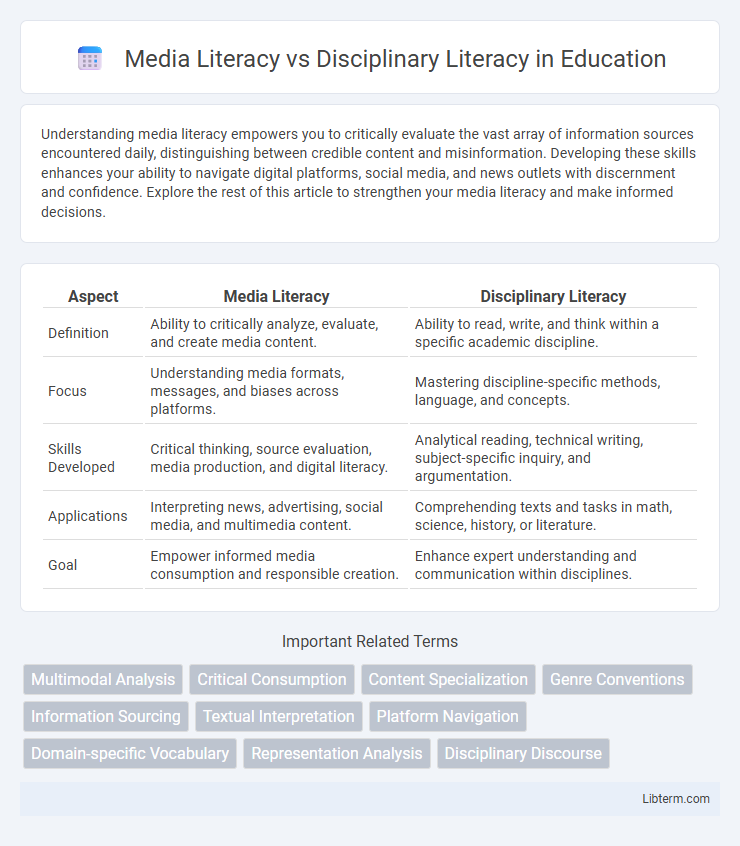Understanding media literacy empowers you to critically evaluate the vast array of information sources encountered daily, distinguishing between credible content and misinformation. Developing these skills enhances your ability to navigate digital platforms, social media, and news outlets with discernment and confidence. Explore the rest of this article to strengthen your media literacy and make informed decisions.
Table of Comparison
| Aspect | Media Literacy | Disciplinary Literacy |
|---|---|---|
| Definition | Ability to critically analyze, evaluate, and create media content. | Ability to read, write, and think within a specific academic discipline. |
| Focus | Understanding media formats, messages, and biases across platforms. | Mastering discipline-specific methods, language, and concepts. |
| Skills Developed | Critical thinking, source evaluation, media production, and digital literacy. | Analytical reading, technical writing, subject-specific inquiry, and argumentation. |
| Applications | Interpreting news, advertising, social media, and multimedia content. | Comprehending texts and tasks in math, science, history, or literature. |
| Goal | Empower informed media consumption and responsible creation. | Enhance expert understanding and communication within disciplines. |
Understanding Media Literacy: Definition and Scope
Media literacy encompasses the ability to critically analyze, evaluate, and create content across various digital platforms, enabling individuals to interpret messages within social, cultural, and political contexts. Disciplinary literacy refers to the specialized reading, writing, and communication skills unique to specific academic subjects or professions. Understanding media literacy involves recognizing its broad scope, which includes decoding media messages, identifying bias, and navigating the influence of media on public opinion and behavior.
Exploring Disciplinary Literacy: Key Concepts
Exploring disciplinary literacy involves understanding how specific academic fields require unique reading, writing, and thinking skills tailored to their content and methodologies. This approach emphasizes mastering the language, tools, and reasoning that experts use within disciplines such as science, history, or mathematics. Key concepts include interpreting domain-specific texts, employing specialized vocabulary, and engaging in discipline-appropriate inquiry and argumentation.
Core Skills in Media Literacy
Core skills in media literacy include critical analysis, evaluation of source credibility, and understanding media messages' purpose and target audience. Media literacy emphasizes decoding visual and audio elements, recognizing bias and misinformation, and creating responsible digital content. These skills enable individuals to navigate and interpret diverse media platforms effectively, distinguishing it from disciplinary literacy's focus on subject-specific reading and writing competencies.
Core Skills in Disciplinary Literacy
Disciplinary literacy centers on mastering core skills such as critical analysis, subject-specific vocabulary, and interpreting content through the lens of particular academic disciplines like science, history, or math. These core skills enable students to engage deeply with texts by utilizing the methods and thought processes unique to each discipline. Media literacy, by contrast, emphasizes understanding and evaluating multimedia content, but disciplinary literacy demands a nuanced application of cognitive strategies tailored to specialized fields of study.
Comparing the Purposes of Each Literacy
Media literacy primarily aims to develop critical thinking skills to analyze, evaluate, and create messages across various media platforms, enabling individuals to navigate the complexities of digital communication effectively. Disciplinary literacy focuses on mastering the unique reading, writing, and thinking skills specific to individual academic subjects, such as science, history, or mathematics. Both literacies seek to enhance understanding and communication, but media literacy addresses broad media consumption while disciplinary literacy targets subject-specific knowledge and cognitive processes.
Media Literacy in the Digital Age
Media Literacy in the digital age emphasizes the critical analysis and evaluation of content across diverse digital platforms, empowering individuals to discern credible information from misinformation. This skill set includes understanding algorithms, recognizing bias, and navigating social media's influence on public opinion and personal privacy. Unlike Disciplinary Literacy, which centers on mastering subject-specific content, Media Literacy focuses on developing adaptive strategies for interpreting multimedia messages in a rapidly evolving digital environment.
Disciplinary Literacy Across Academic Subjects
Disciplinary literacy emphasizes specialized reading, writing, and thinking skills unique to academic subjects such as science, history, and mathematics, enabling deeper comprehension and critical analysis within each discipline. This approach requires students to engage with subject-specific texts, vocabulary, and methodologies, fostering expertise in interpreting complex content relevant to each field. Mastery of disciplinary literacy supports academic success by promoting nuanced understanding and effective communication tailored to distinct scholarly contexts.
Challenges in Teaching Media Literacy vs Disciplinary Literacy
Teaching media literacy presents challenges such as rapidly evolving digital platforms, diverse content formats, and students' varying access to technology. Disciplinary literacy faces difficulties in integrating subject-specific reading, writing, and critical thinking skills while aligning with standardized curricula and assessments. Both require tailored instructional strategies to address cognitive demands and promote critical analysis within their distinct contexts.
Integrating Both Literacies in Education
Integrating media literacy and disciplinary literacy in education enhances students' critical thinking and content comprehension by teaching them to analyze media messages within specific subject contexts. Combining these literacies equips learners with skills to evaluate digital sources and apply discipline-specific strategies, fostering deeper understanding and responsible information consumption. Effective integration involves embedding media literacy practices into curriculum frameworks across subjects like science, history, and language arts to create a cohesive, media-aware learning environment.
The Future of Literacy: Bridging Media and Disciplinary Practices
The future of literacy demands an integrated approach that bridges media literacy and disciplinary literacy to equip learners with critical skills for navigating diverse information landscapes. Media literacy enhances the ability to critically analyze digital content, while disciplinary literacy deepens subject-specific understanding, fostering more nuanced knowledge construction. Combining these literacies prepares individuals to engage effectively with complex media environments and disciplinary texts, supporting informed decision-making and lifelong learning.
Media Literacy Infographic

 libterm.com
libterm.com